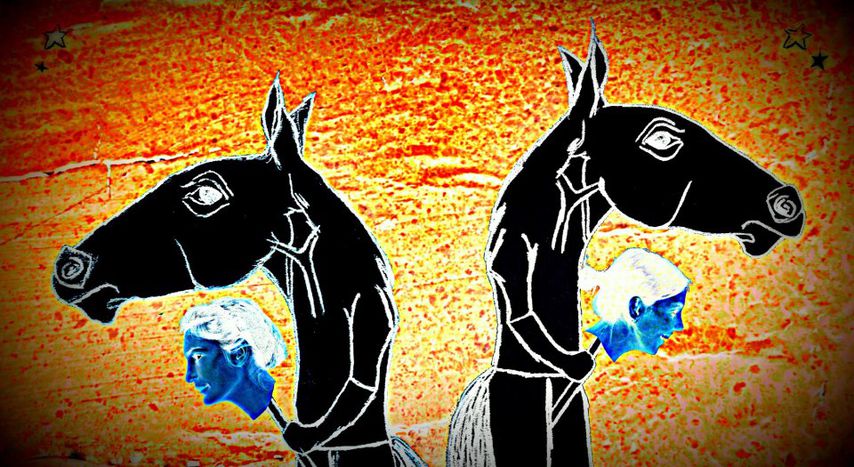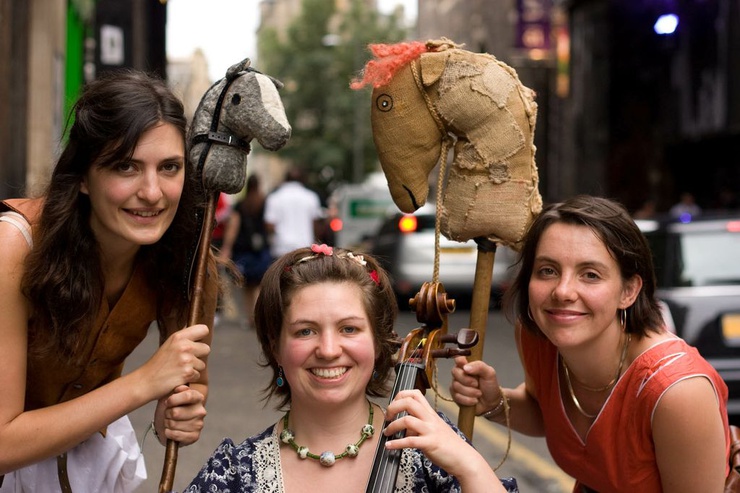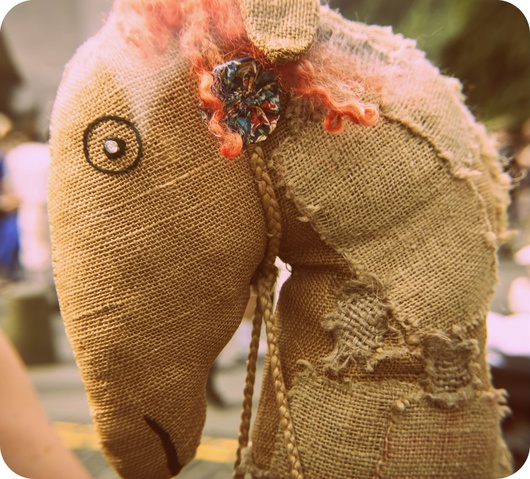
‘Now.Here’: Hobby horse journey from mid-Wales to London
Published on
In a tongue-in-cheek odyssey, Aimee Corbett and Vanessa Hammick journeyed on hobby horse from mid-Wales to London, collecting stories from everyone they encountered. In the guise of the theatre group Drawn to Stars, they later wove their adventures into a theatre piece. We chat with them and the group’s musician Ellen Jordan about isolation and collecting stories
I meet Aimee, 27, Vanessa, 29, and Ellen, 23, at the Edinburgh Fringe Festival in August 2012. The performance of Now.Here, their pensive but playful theatre piece, has just ended. Drawn to Stars had very little funding, other than a Taylor bursary of 300 pounds as well as a residency with the Willow globe in Wales (where they also found one of their hobby horses). They mainly worked on a shoestring, staying with couchsurfers and friends of friends, as well as running workshops to fund their trip to Edinburgh. Now, taking shelter from the festival crowds of students, artists and tourists, we share a pimm’s ice lolly whilst enjoying a view over Edinburgh’s landmark crags. Their trusty steeds resting by their sides, the girls constantly interrupt each other, keeping up a steady but always affectionate riposte. There are frequent explosions of laughter.

Hobby time
The initial idea was partly sparked by the reality of living at a time when jobs outside the main metropolises are few and far between. ‘I was working for Theatre Powys back then with Ian, who’s now our director,’ explains Amy. ‘The theatre got their funding withdrawn from Arts Council of Wales and had to close down. I was left in mid-Wales, trying to find a job and a life for myself – but there’s such a lack of employment possibilities, especially in theatre!’ She laughs at the hopelessness of it. ‘I started thinking about London and these ideas of Dick Whittington and the country mouse. Talking to Vee about that these ideas developed, as sort of seeking our fortunes.
‘Some people are like, I don’t know any stories’ remarks Aimee, ‘and you have to say, yes you do, your whole life is a story.’
'This modern sense of dislocation in everyday life is evident in Now.Here. ‘We met a lot of very isolated people, young and old,’ explains Aimee. ‘I was very shocked by that. Just seeing and meeting so many other people with these anxieties of trying to belong somewhere puts it into perspective. It’s huge at the moment – it’s not just something our generation is dealing with. We’ve been very careful – the stories people told us really touched us. Some of the stories are kind of wacky, but we tried really hard just to tell them as they are. We’re all so quick to judge normally, but these people are just very human.’

Respect
Vanessa agrees. ‘We tried not to impersonate them, or even to play them as characters - just lent them a bit of an accent, otherwise they’d all be from bloody Croydon and mid-Wales! We can’t make these people into cardboard caricatures - we know them and a lot of them fed us!’ Ellen nods emphatically. ‘You’ve got this shared experience and you don’t want to dishonour that fact. There is a certain amount of trust that people had to have in you.’ Aimee adds: ‘People sometimes let something on when they’re not quite sure or they’d realised it had slipped out and they’d leave a silence or quickly move on and you had to really listen for the thing that was important to them. That had a lot to do with the name of the play, Now.Here – a lot of it was about being in the moment, learning how to be present in the now and the here.’
 ‘Often, I found they’d be this pattern when people told their stories,’ reflects Vanessa. ‘You’d be listening but suddenly it got you and you were really involved in their story and you cared about it as much as they did.’ She pauses as though trying to grasp the right word. ‘That was really a kind of now/here thing. I don’t know if it crossed the boundary into being more personal or if you just got a sense of what was important to them. That’s listening, isn’t it? Giving someone time and space, and being in the present with them.’ Collecting stories wasn’t always particularly easy. ‘Some people are like, I don’t know any stories’ remarks Aimee, ‘and you have to say, yes you do, your whole life is a story.’
‘Often, I found they’d be this pattern when people told their stories,’ reflects Vanessa. ‘You’d be listening but suddenly it got you and you were really involved in their story and you cared about it as much as they did.’ She pauses as though trying to grasp the right word. ‘That was really a kind of now/here thing. I don’t know if it crossed the boundary into being more personal or if you just got a sense of what was important to them. That’s listening, isn’t it? Giving someone time and space, and being in the present with them.’ Collecting stories wasn’t always particularly easy. ‘Some people are like, I don’t know any stories’ remarks Aimee, ‘and you have to say, yes you do, your whole life is a story.’
‘Sometimes when we met people, we’d tell stories to invite stories,’ develops Vanessa. ‘If I say, ‘We met this woman who dyed wool these colours’, people might say, ‘Oh yeah, I do tapestry for fun, in fact I got into it because… ‘ And then you get a story. We had met this woman who dyed these sheep - dyed wool, I mean! - I just loved her. I got carried away by the fiction idea of the whole thing. Sometimes I’d tell people just for the fun of it that she fed the sheep the different plants which you use to dye and then their wool just grew that colour and then we’d show them the evidence. I’d always tell them I was lying in the end. But actually that’s what I love, the Gulliver’s travel idea.’
Images: main (cc) Aimee Corbett on Facebook, in-text: (cc) courtesy of Drawn to Stars; (cc) courtesy of Drawn Stars on Facebook



